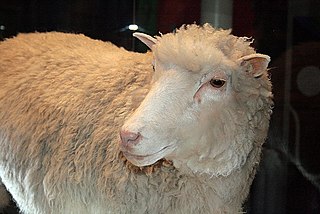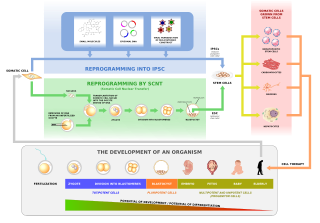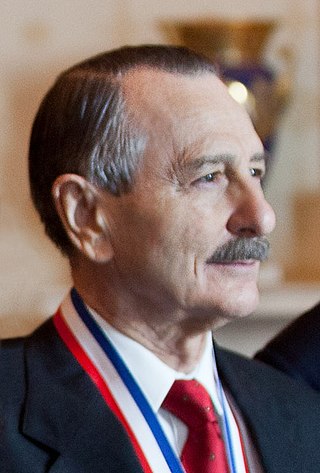Related Research Articles

Cloning is the process of producing individual organisms with identical genomes, either by natural or artificial means. In nature, some organisms produce clones through asexual reproduction; this reproduction of an organism by itself without a mate is known as parthenogenesis. In the field of biotechnology, cloning is the process of creating cloned organisms of cells and of DNA fragments.

Dolly was a female Finn-Dorset sheep and the first mammal that was cloned from an adult somatic cell. She was cloned by associates of the Roslin Institute in Scotland, using the process of nuclear transfer from a cell taken from a mammary gland. Her cloning proved that a cloned organism could be produced from a mature cell from a specific body part. Contrary to popular belief, she was not the first animal to be cloned.

Human cloning is the creation of a genetically identical copy of a human. The term is generally used to refer to artificial human cloning, which is the reproduction of human cells and tissue. It does not refer to the natural conception and delivery of identical twins. The possibilities of human cloning have raised controversies. These ethical concerns have prompted several nations to pass laws regarding human cloning.

In multicellular organisms, stem cells are undifferentiated or partially differentiated cells that can change into various types of cells and proliferate indefinitely to produce more of the same stem cell. They are the earliest type of cell in a cell lineage. They are found in both embryonic and adult organisms, but they have slightly different properties in each. They are usually distinguished from progenitor cells, which cannot divide indefinitely, and precursor or blast cells, which are usually committed to differentiating into one cell type.

An embryo is the initial stage of development for a multicellular organism. In organisms that reproduce sexually, embryonic development is the part of the life cycle that begins just after fertilization of the female egg cell by the male sperm cell. The resulting fusion of these two cells produces a single-celled zygote that undergoes many cell divisions that produce cells known as blastomeres. The blastomeres are arranged as a solid ball that when reaching a certain size, called a morula, takes in fluid to create a cavity called a blastocoel. The structure is then termed a blastula, or a blastocyst in mammals.

A genetic chimerism or chimera is a single organism composed of cells with more than one distinct genotype. In animals and human chimeras, this means an individual derived from two or more zygotes, which can include possessing blood cells of different blood types, and subtle variations in form (phenotype). Animal chimeras are produced by the merger of two embryos. In plant chimeras, however, the distinct types of tissue may originate from the same zygote, and the difference is often due to mutation during ordinary cell division. Normally, genetic chimerism is not visible on casual inspection; however, it has been detected in the course of proving parentage. In contrast, an individual where each cell contains genetic material from two organisms of different breeds, varieties, species or genera is called a hybrid.

In genetics and developmental biology, somatic cell nuclear transfer (SCNT) is a laboratory strategy for creating a viable embryo from a body cell and an egg cell. The technique consists of taking a denucleated oocyte and implanting a donor nucleus from a somatic (body) cell. It is used in both therapeutic and reproductive cloning. In 1996, Dolly the sheep became famous for being the first successful case of the reproductive cloning of a mammal. In January 2018, a team of scientists in Shanghai announced the successful cloning of two female crab-eating macaques from foetal nuclei.

Embryonic stem cells (ESCs) are pluripotent stem cells derived from the inner cell mass of a blastocyst, an early-stage pre-implantation embryo. Human embryos reach the blastocyst stage 4–5 days post fertilization, at which time they consist of 50–150 cells. Isolating the inner cell mass (embryoblast) using immunosurgery results in destruction of the blastocyst, a process which raises ethical issues, including whether or not embryos at the pre-implantation stage have the same moral considerations as embryos in the post-implantation stage of development.

Nuclear transfer is a form of cloning. The step involves removing the DNA from an oocyte, and injecting the nucleus which contains the DNA to be cloned. In rare instances, the newly constructed cell will divide normally, replicating the new DNA while remaining in a pluripotent state. If the cloned cells are placed in the uterus of a female mammal, a cloned organism develops to term in rare instances. This is how Dolly the Sheep and many other species were cloned. Cows are commonly cloned to select those that have the best milk production. On 24 January 2018, two monkey clones were reported to have been created with the technique for the first time.
In biology, reprogramming refers to erasure and remodeling of epigenetic marks, such as DNA methylation, during mammalian development or in cell culture. Such control is also often associated with alternative covalent modifications of histones.
Megan and Morag, two domestic sheep, were the first mammals to have been successfully cloned from differentiated cells. They are not to be confused with Dolly the sheep which was the first animal to be successfully cloned from an adult somatic cell or Polly the sheep which was the first cloned and transgenic animal. Megan and Morag, like Dolly and Polly, were cloned at the Roslin Institute in Edinburgh, Scotland in 1995.
A frozen zoo is a storage facility in which genetic materials taken from animals are stored at very low temperatures (−196 °C) in tanks of liquid nitrogen. Material preserved in this way can be stored indefinitely and used for artificial insemination, in vitro fertilization, embryo transfer, and cloning. There are a few frozen zoos across the world that implement this technology for conservation efforts. Several different species have been introduced to this technology, including the Pyrenean ibex, Black-footed ferret, and potentially the white rhinoceros.

Ralph Lawrence Brinster is an American geneticist, National Medal of Science laureate, and Richard King Mellon Professor of Reproductive Physiology at the School of Veterinary Medicine, University of Pennsylvania.
Stemagen is a corporation headed by Dr. Samuel Wood, notable for cloning adult skin cells On January, 2008, Dr. Andrew French, Stemagen's chief scientific officer and Wood in California, announced that they successfully created the first 5 mature human embryos using DNA from adult skin cells, aiming to provide a less-controversial source of viable embryonic stem cells. Dr. Wood and a colleague donated skin cells, and DNA from those cells was transferred to human eggs. It is not clear if the embryos produced would have been capable of further development, but Dr. Wood stated that if that were possible, using the technology for reproductive cloning would be both unethical and illegal. The 5 cloned embryos, created in Stemagen Corporation lab, in La Jolla, were later destroyed to confirm the nuclear transfer process.
Keith Henry Stockman Campbell was a British biologist who was a member of the team at Roslin Institute that in 1996 first cloned a mammal, a Finnish Dorset lamb named Dolly, from fully differentiated adult mammary cells. He was Professor of Animal Development at the University of Nottingham. In 2008, he received the Shaw Prize for Medicine and Life Sciences jointly with Ian Wilmut and Shinya Yamanaka for "their works on the cell differentiation in mammals".
Embryomics is the identification, characterization and study of the diverse cell types which arise during embryogenesis, especially as this relates to the location and developmental history of cells in the embryo. Cell type may be determined according to several criteria: location in the developing embryo, gene expression as indicated by protein and nucleic acid markers and surface antigens, and also position on the embryogenic tree.
Interspecific pregnancy is the pregnancy involving an embryo or fetus belonging to another species than the carrier. Strictly, it excludes the situation where the fetus is a hybrid of the carrier and another species, thereby excluding the possibility that the carrier is the biological mother of the offspring. Strictly, interspecific pregnancy is also distinguished from endoparasitism, where parasite offspring grow inside the organism of another species, not necessarily in the womb.

Cell potency is a cell's ability to differentiate into other cell types. The more cell types a cell can differentiate into, the greater its potency. Potency is also described as the gene activation potential within a cell, which like a continuum, begins with totipotency to designate a cell with the most differentiation potential, pluripotency, multipotency, oligopotency, and finally unipotency.

Zhong Zhong and Hua Hua are a pair of identical crab-eating macaques that were created through somatic cell nuclear transfer (SCNT), the same cloning technique that produced Dolly the sheep in 1996. They are the first cloned primates produced by this technique. Unlike previous attempts to clone monkeys, the donated nuclei came from fetal cells, not embryonic cells. The primates were born from two independent surrogate pregnancies at the Institute of Neuroscience of the Chinese Academy of Sciences in Shanghai.
The Hwang affair, or Hwang scandal, or Hwanggate, is a case of scientific misconduct and ethical issues surrounding a South Korean biologist, Hwang Woo-suk, who claimed to have created the first human embryonic stem cells by cloning in 2004. Hwang and his research team at the Seoul National University reported in the journal Science that they successfully developed a somatic cell nuclear transfer method with which they made the stem cells. In 2005, they published again in Science the successful cloning of 11 person-specific stem cells using 185 human eggs. The research was hailed as "a ground-breaking paper" in science. Hwang was elevated as "the pride of Korea", "national hero" [of Korea], and a "supreme scientist", to international praise and fame. Recognitions and honours immediately followed, including South Korea's Presidential Award in Science and Technology, and Time magazine listing him among the "People Who Mattered 2004" and the most influential people "The 2004 Time 100".
References
- ↑ "Wood bio". RSC. Archived from the original on March 9, 2012. Retrieved March 7, 2012.
- ↑ Wood, SH; Collins, JM; J Biol Chem (June 1986). "Preferential Binding of DNA Primase to the Nuclear Matrix in HeLa Cells" (PDF). The Journal of Biological Chemistry. 261 (16): 7119–7122. doi: 10.1016/S0021-9258(17)38363-1 . PMID 3711079.
- ↑ Collins, JM; Wood, SH; Chu, AK (December 1989). "Nucleoids, a subnuclear system capable of chain elongation". Biochimica et Biophysica Acta (BBA) - Gene Structure and Expression. 1009 (3). Elsevier: 264–276. doi:10.1016/0167-4781(89)90112-7. PMID 2597677.
- ↑ Wood, SH; Mortola, JF; Chan,F; Moossazadeh, F; Yen, SSC (September 1992). "Treatment of Premenstrual Syndrome with Fluoxetine: A Double-Blind, Placebo-Controlled, Crossover Study". Obstetrics & Gynecology . 80 (3). Lippincott Williams & Wilkins: 339–344. PMID 1495689.
- ↑ Chan, AF; Mortola, JF; Wood, SH; Yen, SSC (December 1994). "Persistence of Premenstrual Syndrome During Low-Dose Administration of the Progesterone Antagonist RU 486". Obstetrics & Gynecology. 84 (6). Lippincott Williams & Wilkins: 1001–1005. PMID 7970453.
- ↑ Adams, CA; Anderson, LS; Scroop, AL; Wood, SH (September 2003). "Gestational Surrogacy Enhances Implantation Rates in Egg Donation Cycles". Fertility and Sterility. 80 (3): 135. doi: 10.1016/S0015-0282(03)01234-2 .
- ↑ Kennedy, D. (2006). Donald Kennedy (ed.). "Editorial Retraction: "Retraction of Hwang et.al". Science. 308 (5729): 1777–1783. doi: 10.1126/science.1124926 . PMID 16410485. S2CID 220109270.
- ↑ French, AJ; Wood, SH; Trounson, AO (2006). "Human Therapeutic Cloning (NTSC): Applying Research from Mammalian Reproductive Cloning". Stem Cell Reviews and Reports. 2 (4): 265–276. doi:10.1007/BF02698053. PMID 17848713. S2CID 32122823.
- 1 2 3 Somers, Terri (January 18, 2008). "Biotech Stemagen fused skin and egg to clone embryo". The San Diego Union-Tribune . Retrieved December 18, 2017.
- 1 2 Ricks, Delthia (January 18, 2008). "Scientists make human embryo clone". Newsday . Archived from the original on January 22, 2008. Retrieved March 1, 2012.
- 1 2 "Stemagen First to Create Cloned Human Embryos From Adult Cells". Prinewswire: Genetic Engineering & Biotechnology News. January 17, 2008. Archived from the original on January 25, 2008.
- 1 2 Weiss, Rick (January 18, 2008). "Mature Human Embryos Created From Adult Skin Cells". The Washington Post . Retrieved December 18, 2017.
- ↑ French, Andrew J., Cathrine A. Adams et al. Development of Human cloned Blastocyst Following Somatic Cell Nuclear Transfer (SCNT) with Adult Fibroblasts Stem Cells published by AlphaMed Press January 17, 2008. doi : 10.1634/stemcells.2007-0252